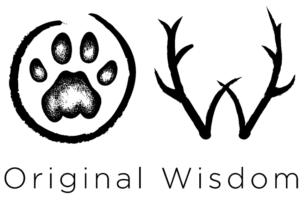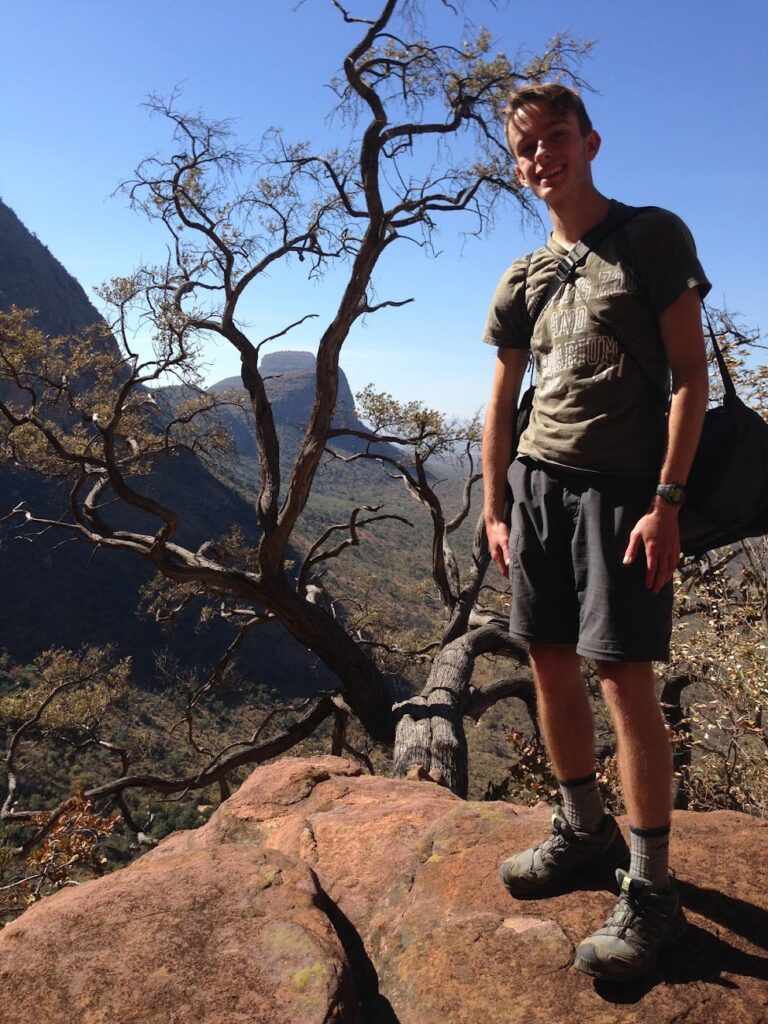Answer Day for 6 – 11 May 2020
Answer list: African tree squirrel tracks from the Republic of South Africa, two different sizes of caterpillar frass from the Republic of South Africa, European mole mounds from southern England, regurgitated pellets of an Abyssinian long-eared owl from Ethiopia, sapsucker feeding wells from New England in the USA, pheasant tracks from southern England
Amongst our global efforts to #flattenthecurve, we shared a few tracking photos on our Original Wisdom social media to help pass the time and keep our learning going. We posted a question a day, except for Tuesdays because that’s Answer Day!
The art and science of tracking develops creative and critical thinking skills, and curiosity and empathy, which also help us to better understand our place as caretakers of this beautiful world. The full expression of tracking includes more than just identifying tracks and signs. It also includes the interpretation of behaviours from tracks and signs, and the following and finding of animals (or people) using tracks and signs. Following and finding, or trailing, also builds confidence and leadership qualities in individuals, and teamwork among groups. Tracking requires us to really see the environment, and each other, and to reconnect to fundamental systems of living, which include knowledge of self, and connection to community (including non-human communities) and land. Tracking IS original wisdom. It’s both ancient, and new. Our ancestors tracked animals for food, clothing, shelter, and better quality of life. Today, we push the frontiers of tracking forward by including technology and new discoveries. One of the best things about tracking is that the “book of nature” is so vast that we can never know it all. It’s always exciting and always humbling.
Wednesday, 6 May 2020
Our question today comes from our Ngala Training Camp in the Balule Region of the Greater Kruger Area in South Africa. Who’s tracks?
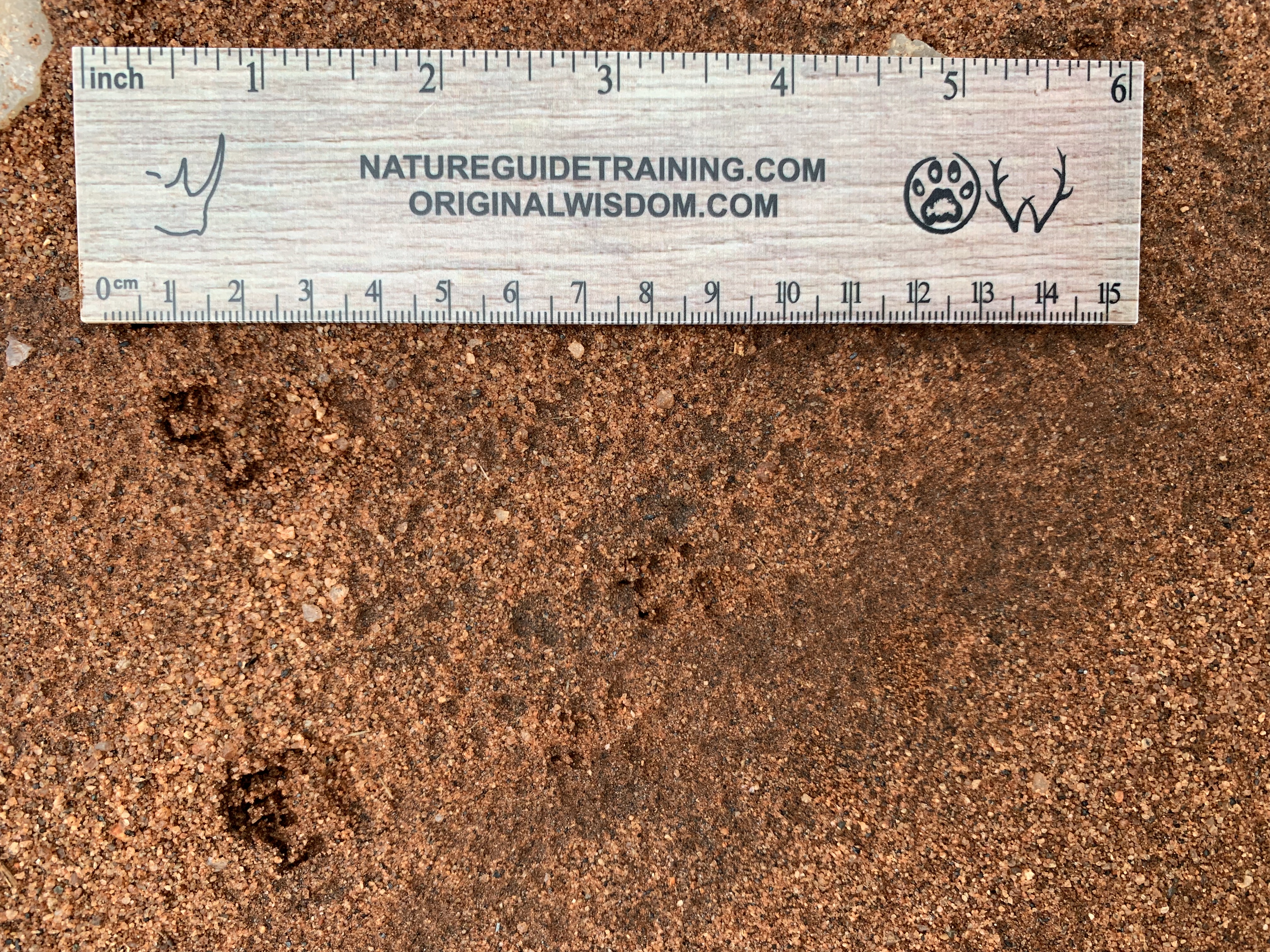
African tree squirrel tracks, from South Africa, photo by Kersey Lawrence
Rowan Davies (RSA), Frikkie Kotze (RSA), and Anya Rose (USA) all guessed rodent, while Rowan and Anya both guessed that these are a squirrel’s tracks. They are, these are the tracks of an African tree squirrel. The animal is moving in a bound from right to left. Bounding, means that the front tracks appear first in the pattern and the hind feet appear second (towards the left edge of the photo). The front feet land and then the animal “bunches” as the hind feet pass the fronts and land, bounding off again. Most rodents, including squirrels, have an additional characteristic, which Anya tried to remember – the front tracks only show 4 toes, while the hind tracks show 5 toes. Additionally, out of those 5 toes in the hind tracks, the middle three are bunched together, like three little parallel lines in a group. We call this classic rodent structure. African tree squirrels are small, about the size of a red squirrel in the USA or Europe, a little bigger than a chipmunk. The individual who’s tracks are shown here is average sized.
Thursday, 7 May 2020
Our question today comes from South Africa but can be found across the world. What is it and who made it? There are two different examples in the photos, one smaller and one larger.
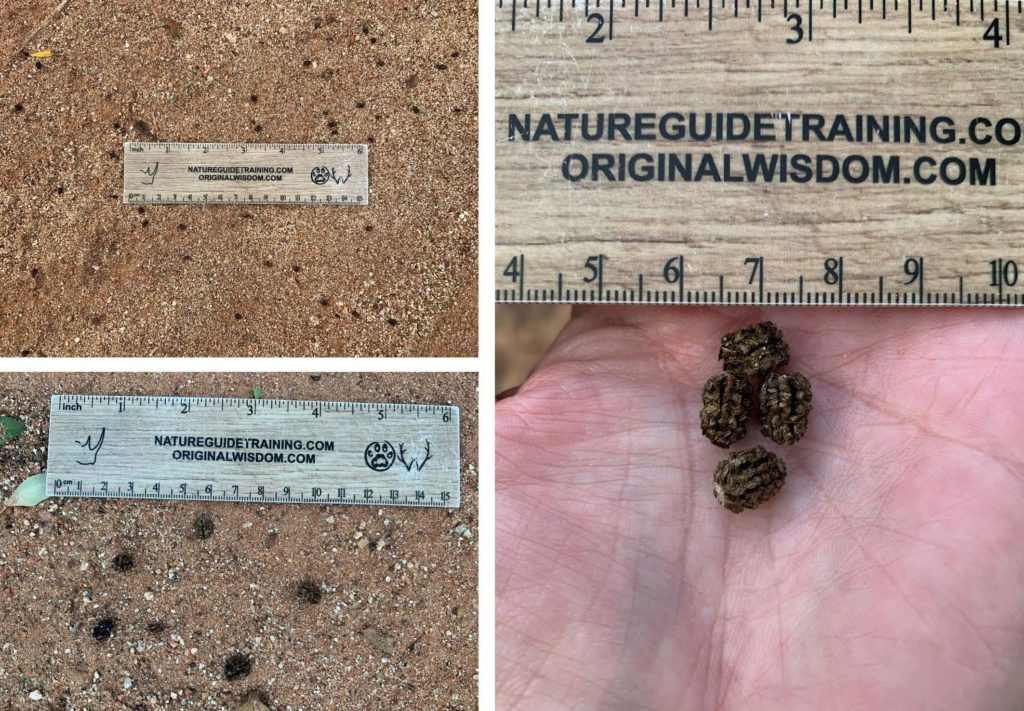
Two different sizes of caterpillar frass, from South Africa, photos by Kersey Lawrence
This one must have been easy, because everyone got it! Congrats to Simone Roters (Germany), Alison Drake (RSA), Mark Apgar (USA), Beau Harger (USA), and Ron Waline (USA) for all going with some kind of caterpillar poo. We actually call it frass. And, as Beau mentioned, “caterpillar frass – Hand grenade looking lines on the scat.”
Friday, 8 May 2020
Our questions today come from Southern England, but various different species are widespread. What is it and who made it?
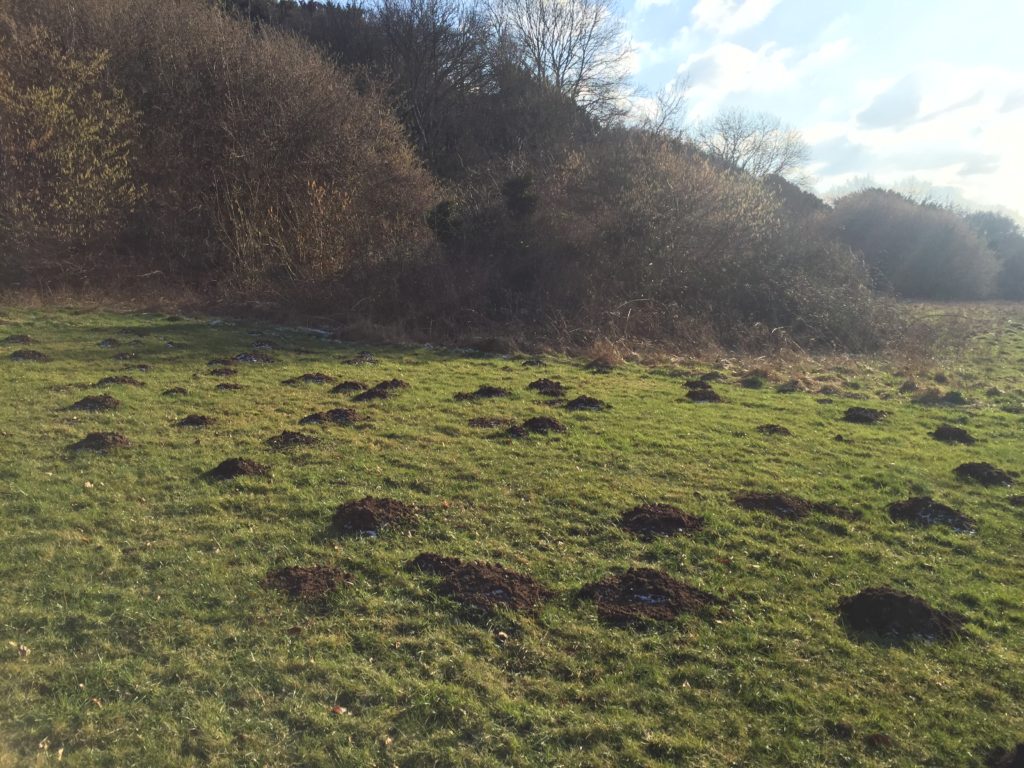
European mole mounds, from southern England, Photo by Kersey Lawrence
Mike Watling (USA), Beau Harger (USA), Thomas Schwenkenbecher (Africa?), and Paul Glasser (USA) all said mole hills. Mike Watling was more specific, with European mole hills, which these are! He explained, “Those are European mole hills. Moles create throw mounds that are circular and resemble a volcano ridge. Moles will plug their holes from the inside unlike other burrowing mammals which leave the entrance open. Beau aptly described them as, “circular volcano-like mounds!” Paul elaborated with, “I believe these are mole hills. They are similar to gopher mounds, but can be distinguished by two criteria. 1) When viewed from above (no above view shown here) you can see that mole hills are circular in shape and that the plugged entrance is in the center of the mound. Gopher mounds are slightly tear-drop shaped and the entrance is at the narrower end of the tear-drop. It is difficult to tell from this photo if the mounds are circular or tear-drop so I made the determination by 2) Mole hills often have visible “plugs” of dirt showing protruding from the mound. I never see this on gopher mounds, but I think I see this on many of these hills so I think these are the work of mole(s). I’m not familiar with the species of moles in UK. Where I live in Oregon this would be attributed to the Townsend mole. We have Coast moles as well, but their activity looks different. And finally, Thomas put the icing on the proverbial cake with, “Haha, very familiar – we even have cake like that (the so called mole cake) ” and attached this photo from the internet:
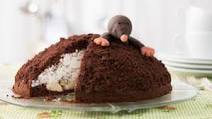
Saturday, 9 May 2020
Our question today comes from Bale Mountain National Park in Ethiopia, but similar items are found from various different species across the world. A generalized answer is fine here, but can you explain how you know and what the process is for these?
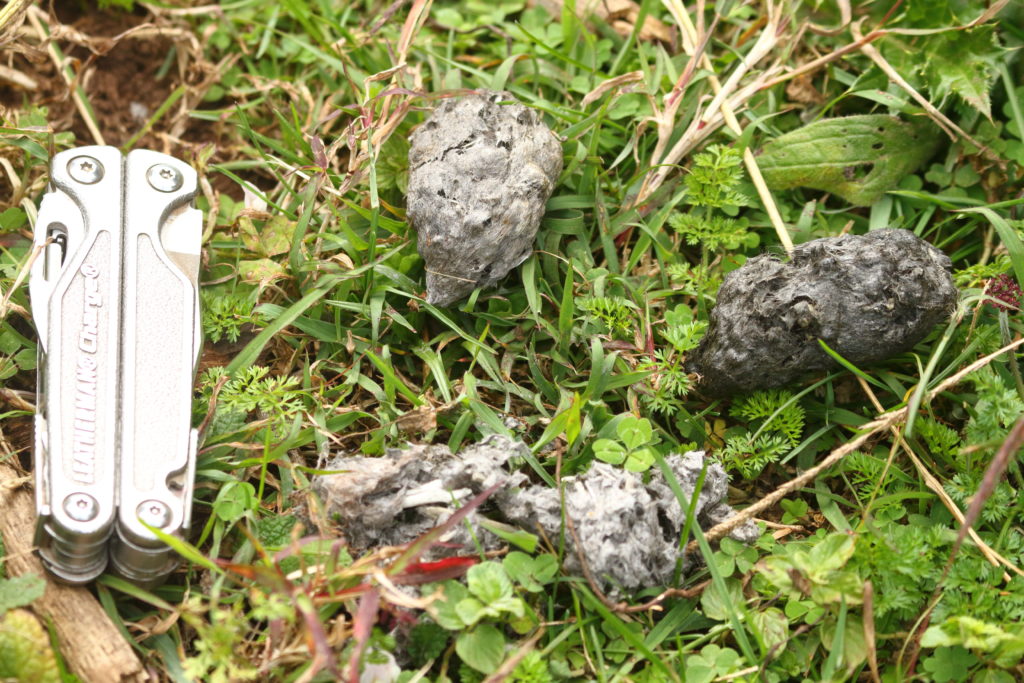
Regurgitated pellets of an Abyssinian long-eared owl, from Bale Mountain National Park in Ethiopia, Photo by Lee Gutteridge
Kristi James (RSA), Mike Watling (USA), Justene Tedder (Canada), and Beau Harger (USA) all guessed some kind of owl pellet for these. They are the regurgitated pellets of an Abyssinian long-eared owl, but, owl pellets was a fine answer. Owls swallow a lot of their prey whole, and the fur of their rodent prey wraps up the larger, indigestible bones, which keeps them from puncturing the bird’s throat on the way back up. Sometimes, you can find a habitual roost, where the bird sits regularly, with many of these underneath it. As Mike mentioned, “They are fun to collect and dissect to determine the dining habits of these great raptors.” Mike goes on to say, “firstly the pellet is a single unit and not segmented like a bobcat scat for example. Secondly, the pellets I’ve seen look like they have are a recycled “paper wrapper” for lack of a better word. More often than not, whole bones are visible (or easily picked out) unlike scat where found bones are often crushed or shattered when consumed. Additionally, pellets do not last long in nature as moisture rapidly breaks them down. Justene reminds us that not only owls regurgitate pellets, many birds do, “the indigestible things like hair, bones, exoskeletons of insects (the case of kingfishers), etc. are not passed through to the gizzard and are regurgitated from the crop of some birds. Because owls often swallow prey while they are more frequent pellet regurgitators!”
Sunday 10 May 2020
Our question today comes from the New England area of the USA. What are these (who made them, what is their function)?
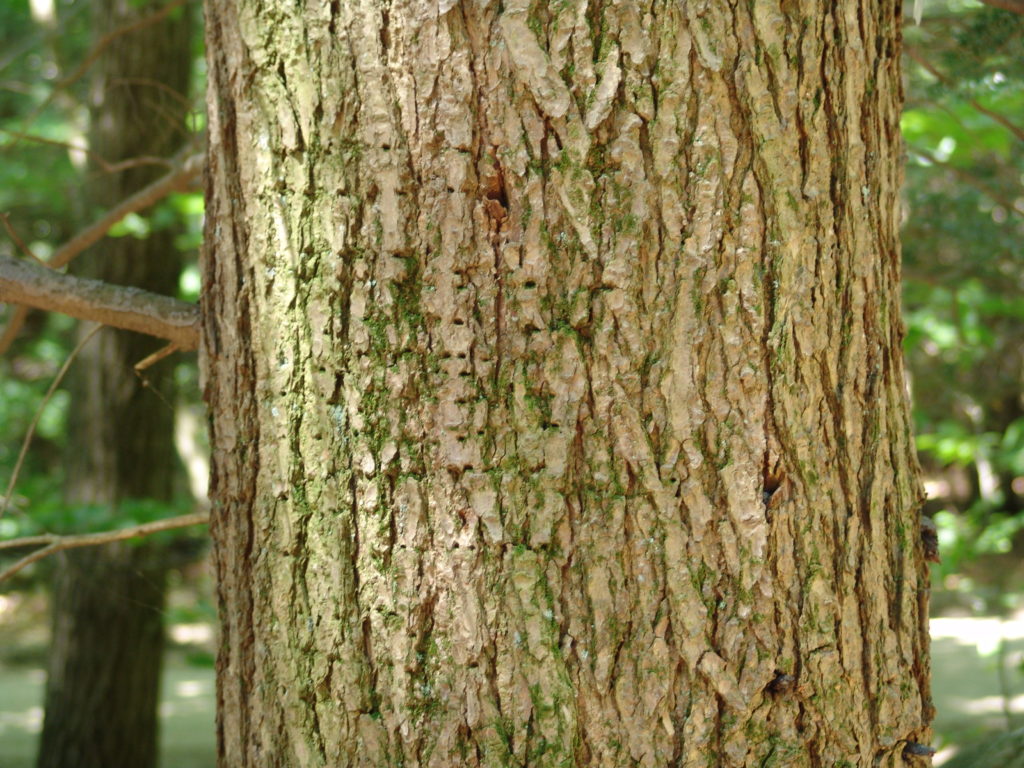
Sapsucker feeding wells (possibly a similarly sized woodpecker), from New England, USA, photo by Kersey Lawrence
Robert Hendrix (USA), Ray Hardy (USA), and Alan Bicknell (USA) all said sapsucker, and in the New England area, these are probably yellow-bellied sapsucker, which is a type of woodpecker, which makes Bren White’s (USA) answer of woodpecker also correct. In fact, we can’t say for sure that other woodpeckers don’t do this, even though this seems like classic feeding signs, sapsucker feeding wells, or xylem wells as Bren calls them, of yellow-bellied sapsuckers. Ray Hardy explained, “They drill small shallow holes in tree bark in this distinctive pattern in order to feed on the sap as well as on insects attracted to the sap.”
Monday 11 May 2020
Our question today comes from Southern England. Who’s track?
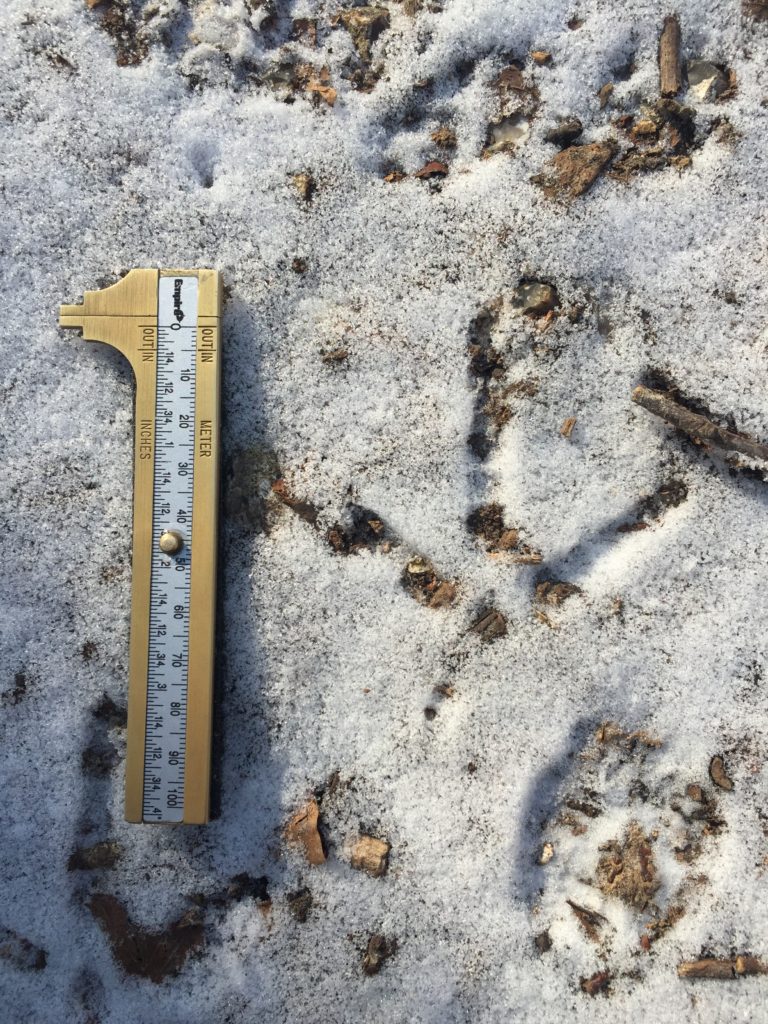
A pheasant track, from southern England, photo by Kersey Lawrence
Blake Samuele Southard (USA) got this one, it’s a pheasant track! In southern England, this is the biggest game bird, everything else would be smaller, except maybe a domestic chicken – but this was taken in a wild are without domestic animals. Blake guessed pheasant, “based on the symmetry of the track, the obvious hallux (hind toe) and the size.” He also added that it’s the right foot and he’s correct, the angle of the hallux points towards the center of the trail.
Thanks to everyone who participated. Let’s keep learning together! If you have photos (with an explanation that you’d like to contribute), please contact me at kersey@originalwisdom.com – your contributions will be credited to you.
#trackingisoriginalwisdom, #natureguidetraining, #cybertracker, #trackercertification, #trackermentoring, #alwaystracking, #environmentaleducation, #ecologicalliteracy, #ecologicalintelligence #wildlifetracking, #animaltracking, #tracksandsigns, #systemsthinking, #ecology, #nature, #science, #conservation, #sustainability, #resilience, #adaptation #thinkinglikeamountain #weareallconnected #BeMoreNeedLess #trackinginafrica #greaterkruger
Download our recommended reading list for trackers by signing up for our “News for Trackers” newsletter!
Our goal is NOT to be spammy with our newsletter. We’d just like to send occasional updates on upcoming programs and maybe some cool info on wildlife, people, and tracking!
Once the sign-up form has been submitted, you will be re-directed to the download page.
Download our recommended tracking book list (and some other resources). It’s specific to Southern Africa and North America, but, a good tracking book is helpful in any region as a starting point to learn how to look at track morphology and animal behavior.
[contact-form-7 id=”2892″ title=”Subscribe to the newsletter”]
